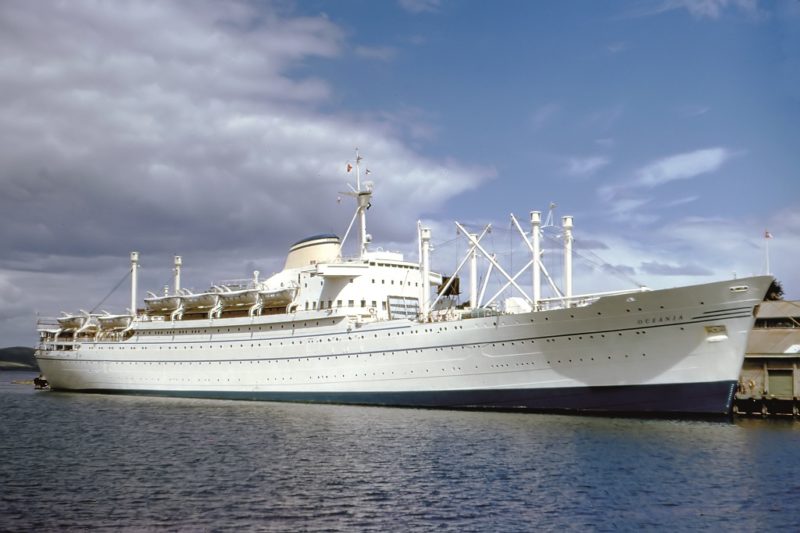
In the wake of the Second World War there was an almost insatiable demand for Europeans seeking to escape their war-ravaged continent and make a fresh start across the oceans. Nowhere proved more enticing than the Antipodes, where the Australian government actively encouraged the migrant tide. Nevertheless, like most of their compatriots, Italy’s Lloyd Triestino’s fleet had been decimated by the conflict, indeed the veteran 9,584grt Toscana, originally the German Saarbrucken, was their only large passenger vessel to survive intact. To meet this surge in traffic the Trieste based company therefore placed an order for three identical 12,389grt vessels with the local Cantieri Riuniti dell ‘Adriatic (CRDA) shipyard. They were allocated yard numbers 1758, 1759 and 1760 and the first keel plates were laid, simultaneously on 15th May 1949.
The trio were the first element of Lloyd Triestino’s post-war reconstruction. In many respects the company was fortunate, the Italians weren’t subject to the moratorium imposed on their erstwhile German allies and were thus able to restart operations as soon as it was feasible. Furthermore, generous Marshall Aid funding, allowing both the restoration of shipyards and shipping, was deliberately channelled to Italy, and the Julian March region in particular, as an ideological buttress against the neighbouring socialist People’s Republic of Yugoslavia. It transpired that forty percent of the new ships’ construction costs were funded directly out of Marshall Plan money.
After a much needed refit and a brief stint on the South Africa run, Toscana resurrected the Italy-Australia service with a departure from Genoa on 19th October 1948. She was soon joined by the first two of a smart looking but somewhat austere new class of cargo liners on charter from the Italian Line. These Navigatori, Ugolino Vivaldi and Sebastiano Caboto, would remain on the Australian service until Lloyd Triestino’s new trio were ready for service.
Amongst great pomp and witnessed by a large crowd including company hierarchy and prominent politicians, the first of Lloyd Triestino’s new vessels, yard number 1758, was launched into the Adriatic as Australia on 21st May 1950. Just over two months later she was followed by Oceania and finally, on 1st October 1950, Neptunia. Fitting out the ships took almost exactly a year. Australia’s maiden voyage, under the command of Captain Francesco Albanese, exceptionally commenced from Trieste on 19th April 1951 and terminated in Brisbane on 24th May. Thereafter she, and subsequently her sisters, operated a regular service between their home port of Genoa and Sydney, initially calling at Naples, Messina, Port Said, Suez, Colombo, Djakarta, Fremantle, Adelaide, and Melbourne outbound and the same ports, except Singapore (before Colombo) Cochin and Aden on the homeward leg. Oceania’s maiden sailing departed from the Ligurian port on 18th August and Neptunia’s on 14th September.
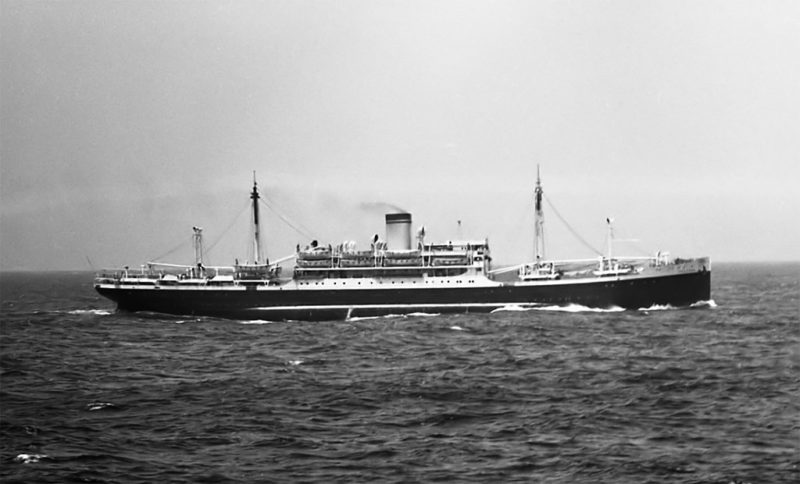
Externally the Australia class and their Italian Line contemporaries, Augustus and Giulio Cesare, also CRDA built, introduced a refreshingly modern, post-war Italian style. That style would go on to influence all compatriots and a good deal of foreign tonnage of the era. The sturdy bow and svelte hull were topped by a neat, gently curved forward superstructure and bridge front. The superstructure was necessarily set quite far back to accommodate the hatches and associated handling gear for three cavernous forward holds. These ships offered 215,577 cu.ft. of cargo capacity in all. Open promenades ran along each flank aft of a forward main lounge, topped by a row of four lifeboats, before the superstructure was fragmented further aft to allow access to two additional cargo holds. Above all it was the distinctive tripod, bridge mounted mast and harmoniously sculpted funnel, which inevitably drew most of the attention. The lower funnel casing blended neatly into the superstructure below. The Australia trio dispensed with the traditional mainmast, and this helped to give them a modern, purposeful silhouette, a look completed by two sets of kingposts and associated booms forward and a single pair aft.
Internally the ships were no less distinctive. The Alta Moda interiors were co-ordinated by some of the most prominent contemporary Italian shipboard designers, including Gustavo Pulitzer Finali, Gio Ponti and the Nordio architectural group based at Trieste.
Accommodation was initially provided for 792 passengers. Despite early advertisements promoting First and Tourist this was initially configured into three classes, 280 in First, 120 in Second and 392 in Third with second and third class sharing public rooms. There were seven passenger decks, delineated in a traditional manner, with First Class mainly central and in the superstructure and Second/Third mainly in the hull and farthest aft and forward. The highest deck, Ponte Comando (Bridge Deck) consisted of outdoor games space, aft of the wheelhouse and surrounding the funnel casing. Heading down, senior officer cabins dominated the forward end of Ponte Sole (Sun Deck), however the diminutive First Class card and children’s rooms were located to port, accessible via an extension of the main First Class stairwell. Aft of the funnel and accessed via a second, central stairwell was the light, bright and very popular Veranda Bar, which opened onto the First Class lido and swimming pool.
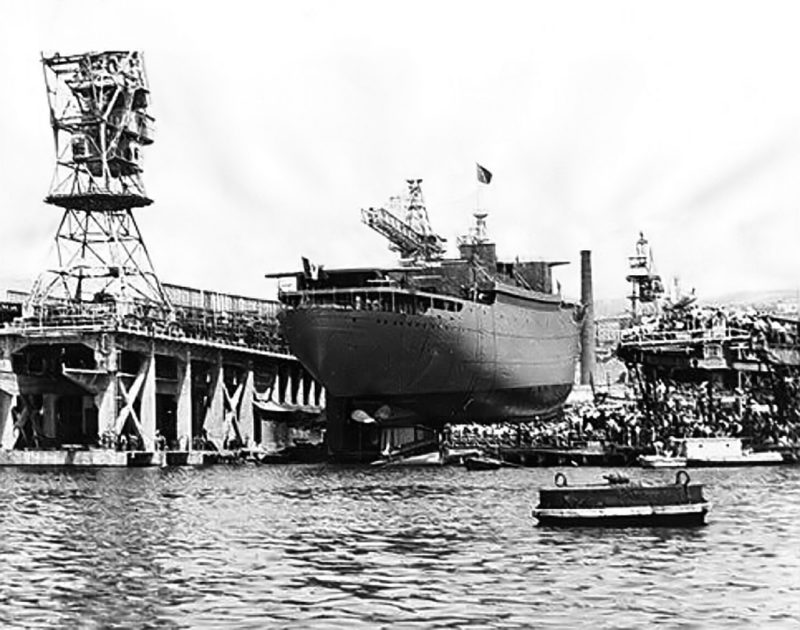
Descending via the forward staircase to Ponte Passeggiata (Promenade Deck), First Class passengers entered a broad and airy lobby. Before them, separated by a glazed wall with two access doors was the First Class lounge. Offering a 270º aspect vista over the bow and flanks, this room was supported by spindly pillars and featured defused lighting and attractive modern furniture. If the linoleum flooring, a feature throughout the ship, lessened the coziness somewhat it nevertheless retained a ‘clubby’ atmosphere, with a central, circular, inlaid dance floor. Augmenting the Lounge, on the starboard side, was a secluded little bar which proved as popular as it was attractive. Both Lounge and Bar felt cool, literally and metaphorically thanks to air-conditioning.
Heading aft on each flank were the broad First Class open promenades, sheltered from the tropical sun by a sloping roof that nestled below the line of four lifeboats. Deckchairs formed a serried row on the inner wall, abutting the radio room, offices and yet more officer accommodation. Two thirds aft, the promenade and lifeboats abruptly ended with a flight of steps down to Ponte Casseri (Upper Deck) and narrowed to provide access to cargo handling equipment and one of the aft holds. Further aft still was the marooned Tourist Class games deck, effectively the roof of the Tourist Class Veranda Bar and bracketed on each side by the second of two supplementary pairs of lifeboats. These had their davits planted on Upper deck and tapered neatly towards the stern.
Forward on Upper Deck was the foc’sle, with its mooring gear and a set of king posts and booms for access to hold number one. Heading aft and vaulting the small well deck on A deck, incorporating the hatch cover for hold number 2, was a second set of king posts and booms and the hatch for hold number three. Aft of the neatly curved forward bulkhead and lining each side of the ships were an assortment of a dozen two, three and four berth First Class cabins. These offered a considerable variety of accommodation, from a pair of inside singles without any toilet facilities, to spacious four berth en suite cabins, including a full tub bath, in which one berth was convertible into a day room sofa. Between these extremes were a variety of configurations, some with their own shower and toilet, others with shared facilities.
Aft of the cabins were the Writing Room (to Port), the Ladies Room (to Starboard) and the lobby of the central stairwell, providing access to the full width First Class Dining Room. Two thirds aft, where the steps from the First Class promenade descended from Promenade Deck was Second and Third Class territory.
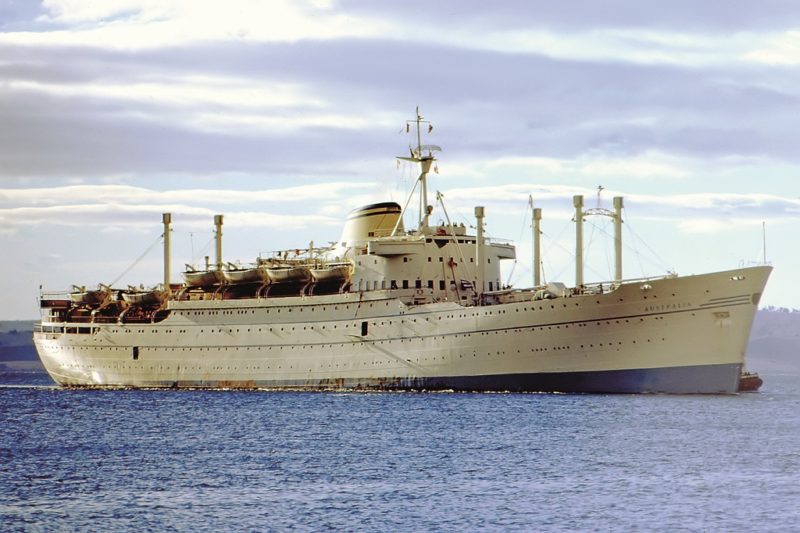
Along each flank (under those two additional pairs of lifeboats) and wrapping around the squared off stern of Upper Deck was a Promenade, meanwhile nestled between the trunking of the rear holds and the forward bulkhead of the Veranda Bar was a sheltered swimming pool and seating area. With its large windows on each flank and French doors opening out onto that squared off stern, the delightful combined Second/Third Class Veranda lounge and bar featured rattan furniture and wood panelling.
A single central flight of steps descended to the fantail on Ponte A (A Deck) and further covered promenade space, sandwiching the main Second/Third Class lounge. Like its First Class equivalent this included a central, circular dance floor. From the adjacent lobby and stairwell passengers could access the writing room and children’s playroom, whilst doors led into the Second/Third Class dining room. This was broadly an ‘H’ shape, with the slender full-width element squeezed between the swimming pool casement aft and hold trunking forward. Like its First Class equivalent and the First Class lounge, the Tourist dining room benefitted from air-conditioning. All other parts of the ships, including cabins, were initially cooled by a ‘Thermotank’ forced ventilation system.
Forward of the dining room were the residual First Class outside cabins, most with shared bathroom facilities although the nine forward of the First Class lobby were en-suite. The lozenge shaped lobby was surrounded by the Purser and Maitre D’s offices, as well as the Purser’s front desk, whilst the ladies hair salon was situated to starboard. As the name suggests this was the main embarkation point for those in the higher echelons of the passenger list, accessed via shell doors on each flank and the lowest point of the main stairwell.
The main embarkation point for Second/Third Class was one deck down and three quarter’s aft on Ponte B (B Deck). The associated lobby again provided a Purser’s office, front desk and a hairdresser. There was also an Emigration Service office for checking and processing that all important paperwork. Second Class cabins were arranged aft, to starboard and forward, some with shared facilities but many necessitating a trip down the corridor to communal toilets, showers and baths. Centrally located on the port side was the ship’s medical facility.

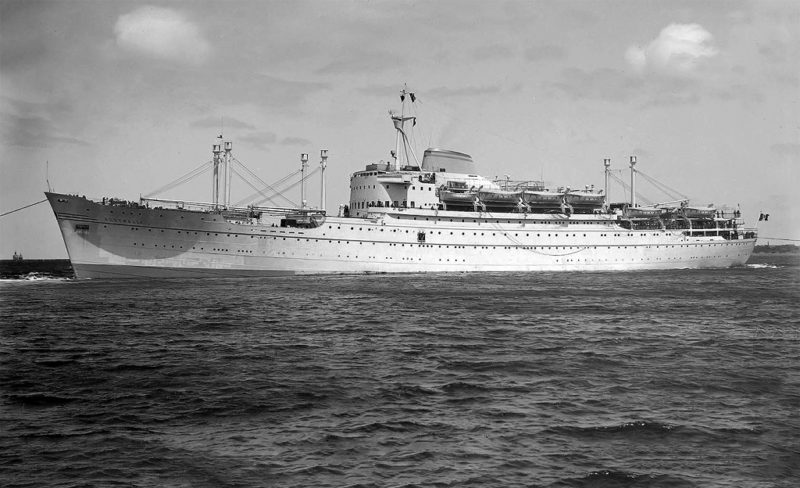
Ponte C (C Deck) was the lowest accessible passenger deck, comprising two ’islands’ of Third Class dormitories with associated bathrooms, located far forward and aft and separated by crew quarters and machinery spaces.
The Australia trio were a distinct step up from the ships they replaced and soon garnered an excellent reputation for the standard of their accommodation and food. Their two sets of CRDA-Sulzer diesels developed 13,000bhp, easily capable of maintaining an 18 knot service speed and offering a roughly monthly service between Genoa and Sydney. These were emigrant workhorses in the traditional sense and a passenger list from January 1954 conveys how broad a spectrum that covered, with 849 migrants from eighteen countries including 140 ’Apolidi’ or stateless persons. The majority were women and children and voyages frequently included births and/or deaths at sea. In general there was no deviation from this perennial liner service, although one distraction is recorded as occurring on 26th December 1952. That Boxing Day, Australia sailed with a complement of yacht enthusiasts, paying £6 per head, to watch the start of the Sydney to Hobart yacht race.
When the assisted passage scheme, by which the Australian subsidised immigrant fares, was extended to include Italians in 1952, demand for Tourist Class berths increased further. Other than the Suez Canal closure in 1956/57 and the consequential re-routing via South Africa and the Atlantic, the ships continued to ply their year round trade without significant drama. Nevertheless times were changing, and the emigrant traffic was increasingly supplemented by a flow of more discerning tourists. With an eye at the competition, Lloyd Triestino sent all three ships for significant refits in 1958/9, although the class nomenclature appears to have changed earlier in the decade. Second became Tourist A and Third became Tourist B respectively, general upgrades and the addition of a spacious new lounge enhanced the experience of Tourist class emigrants and tourists alike. The lounge was built by enclosing the forward well deck.

The focus on Tourist Class reflected the changing times and accommodation was now provided for just 136 in First, with 304 in Tourist ‘A’ and 232 in Tourist ‘B’. Amongst other changes implemented were the installation of complete air-conditioning throughout, and the fragmentation of most of the huge dormitories on C Deck, into more intimate blocks. One set of dormitories was eliminated altogether and made into two and four berth cabins. The changes increased the ships’ gross registered tonnage to 13,226.
The Australia class re-entered service ready for the new decade, however Lloyd Triestino’s focus was already shifting towards replacements, a pair of considerably larger and faster successors. In September 1960 the keels were simultaneously laid on Monfalcone slipways for the company’s final flagships, Galileo Galilei and Gugliemo Marconi. The three incumbent Australia ships were relatively new and certainly in fine condition, especially given the extensive, recent refits. With redundancy looming the state owned corporate structure now provided a solution.
As fate would have it the Italian Line was experiencing increased demand for its Italy to west coast of South America service, with terminal ports at Genoa and Valparaiso respectively. Once more the former Lloyd Triestino vessels were pencilled in to replace the more austere Navigatori, the latter completing FINMARE’s ‘ship swap’ following conversion into twelve passenger freighters for Lloyd Triestino’s South Africa service.
Italia’s new acquisitions, Australia, Oceania and Neptunia were renamed Donizetti, Rossini and Verdi respectively, collectively and affectionately known as the Musicisti. Delays in completing their replacements meant that they entered service with the Italian Line later and more haphazardly than had originally been envisaged. Australia was delivered to her new owners on 4th April 1963, Oceania on 6th May 1963 but with Gugliemo Marconi almost six months behind schedule, Neptunia had to make three additional roundtrips and wasn’t handed over to her new owners until returning to Genoa on 20th October.

Despite Lloyd Triestino’s recent upgrades the Italian Line sent their new acquisitions to a local Genoa yard for a thorough technical overhaul and further enhancements designed to make them suitable for their new service. Amongst the latter was the installation of a desalination plant capable of producing sixty tons of water per day. There was also a further reconfiguration of the accommodation including the elimination of all remaining dormitories, the forward remnants being converted into cabin accommodation, whilst the aft became additional cargo storage. The revised passenger complement comprised 160 in First and 440 Tourist Class. Arguably looking even smarter in Italia’s green, white and red livery, the new trio trimmed three full days off the Genoa-Valparaiso run, which would now take exactly four weeks in each direction. The timetable scheduled sixteen annual roundtrips.
Having completed her refit, Donizetti departed Genoa’s elaborate Ponte Mille for the first time on 9th June 1963, under the command of Captain Salvatore Schiano. Rossini’s maiden voyage commenced on 7th July whilst the much delayed Verdi, replacing the hard working Amerigo Vespucci, belatedly started out on Christmas Day. The Musicisti’s route was amongst the most exotic and enticing of all scheduled liner services. From Genoa they called at Naples, Cannes and Barcelona before entering the Atlantic. A brief call at Tenerife was followed by La Guairá, Curaçao, Cartagena, and Cristobal before transitting the Panama Canal. On the Pacific side of the isthmus, they stopped at Buenaventura (Colombia), Manta and Guayaquil (Equador), Callao (Peru) and finally Arica, Antofagasta and Valparaiso in Chile.
The introduction of the new ships, coupled with the withdrawal of Royal Mail Line’s Reina del Mar, resulted in a rare glimmer of growth for Italia. In 1964 passenger numbers on the West Coast of South America route increased substantially by 15.5%.
Nevertheless, the year was not without its troubles. After a relatively incident free career to that point, the last of class, Verdi, erstwhile Neptunia, collided with the Liberian registered tanker Pentelikon at 2am on 16th April 1964 whilst sailing Westbound in the Straits of Gibraltar. Subsequent investigations placed the blame on Verdi’s Captain, the Italian Line ship having rammed the tanker amidships, in clear weather and whilst trying to pass her and another vessel. Thankfully the tanker was sailing light and there were neither fires nor casualties on either vessel. With her bow badly crumpled the Italian liner limped to the nearby Gibraltar shipyard for temporary repairs before returning to Genoa.
Although largely immune to the jet competition that decimated the Transatlantic trade, even the Musicisti entered the cruise business over Christmas 1966, with a five day Chilean coastal voyage round-trip by Verdi, from Valparaiso to San Antonio and Puerto Montt. What the Valparaiso route wasn’t immune from was the rash of strikes that blighted almost all shipping schedules of the era. With union power at its zenith, stoppages and delays became part and parcel of the passenger ship experience, accelerating its inevitable demise.
Despite generally holding up well by comparison with other services, proposals released in December 1969 included the instant withdrawal of Verdi without replacement. This, together with even more radical plans for the Atlantic service, was dropped in the face of a union backlash but nevertheless the seeds of doubt had been sown. The new decade dawned with the largest units of the Italia fleet, Leonardo da Vinci, Michelangelo and Raffaello, increasingly occupied on the Caribbean and long-distance cruise circuit. In contrast, an increase in Chilean migration led to a healthy 10% increase in passenger loads in 1970. Even five years later there was modest growth on this most unique of routes, but as a company the Italian Line was coming under increasing pressure to rationalise all their operations from the political masters in Rome. On 25th March 1975 the Minister of the Merchant Marine formally announced that all FINMARE deep sea passenger shipping services were to be phased out by the end of 1977. The Musicisti and their fellow South American fleet mate, Cristoforo Colombo, were due to be in the final tranche.
In the event the trio were sacrificed a year early to enable the company’s last cruise ship, Leonardo da Vinci, to embark on a winter programme of cruises from New York. In quick succession the three ships were withdrawn form service, first Donizetti, on her return to Genoa from Valparaiso on 4th July, then Verdi and finally Rossini, which closed out the service with a 22nd July sailing from Chile that arrived back at her home port on 21th August 1976.
Despite attracting the interest of the Orri Navigation Line of Jeddah for Red Sea pilgrim service, the trio languished in lay-up for almost a year, finally being bought for scrap by Terrestre Marittima at La Spezia. They arrived to be summarily dismantled in June and July 1977, after almost quarter of a century of faithful service on two of the longest and most fascinating transoceanic shipping services.
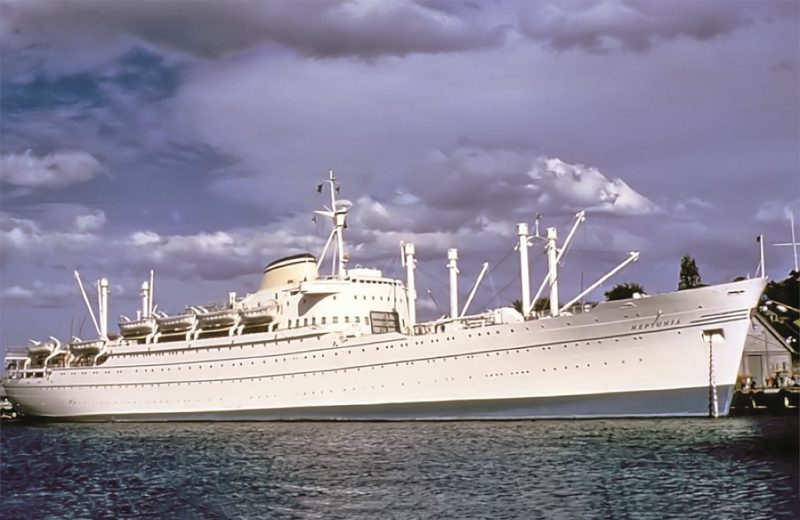

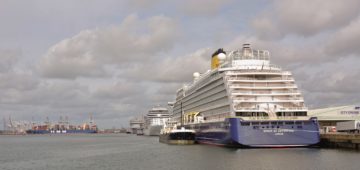



Comments
Sorry, comments are closed for this item